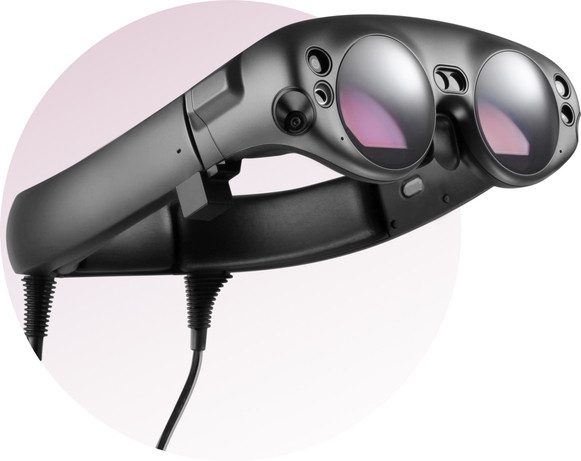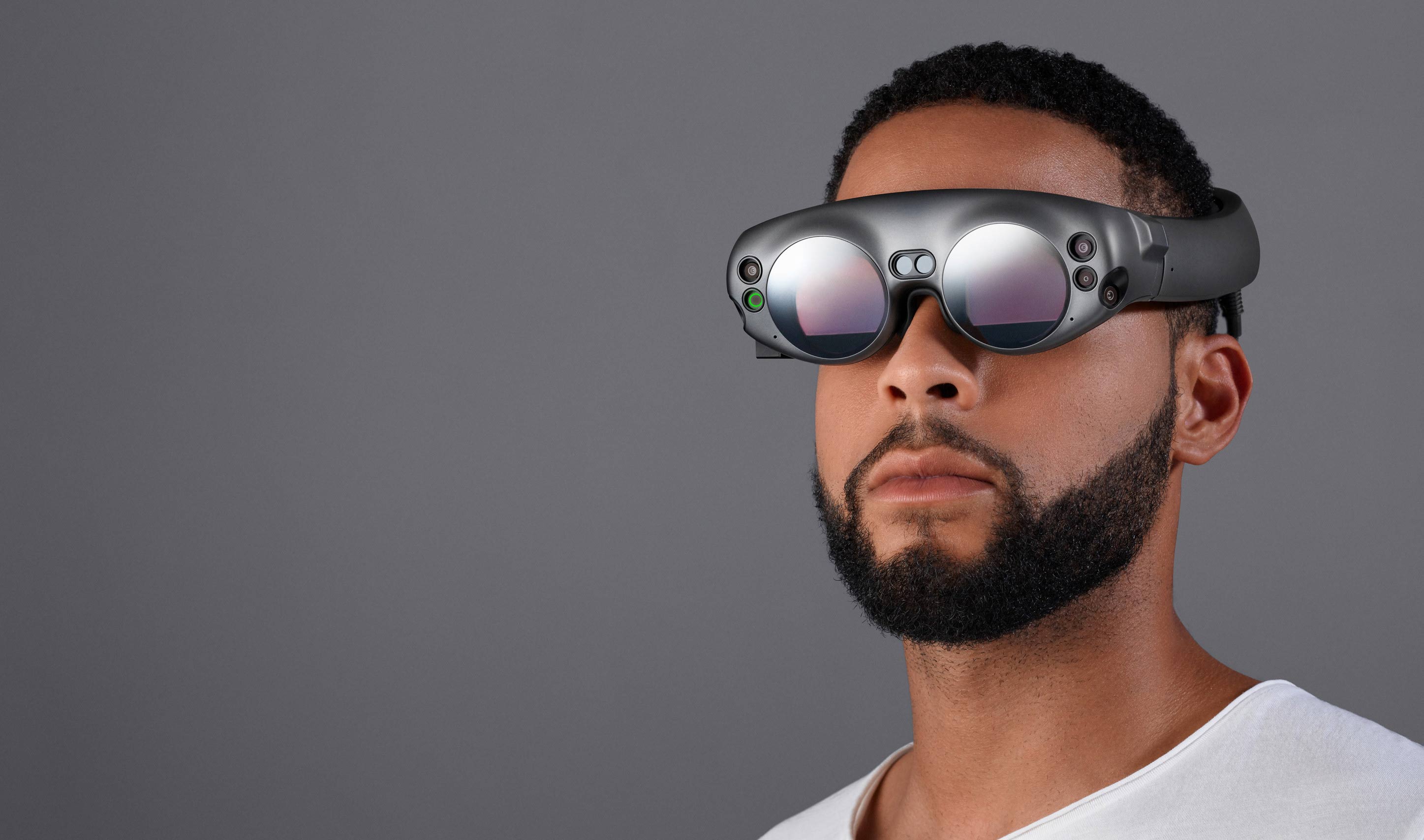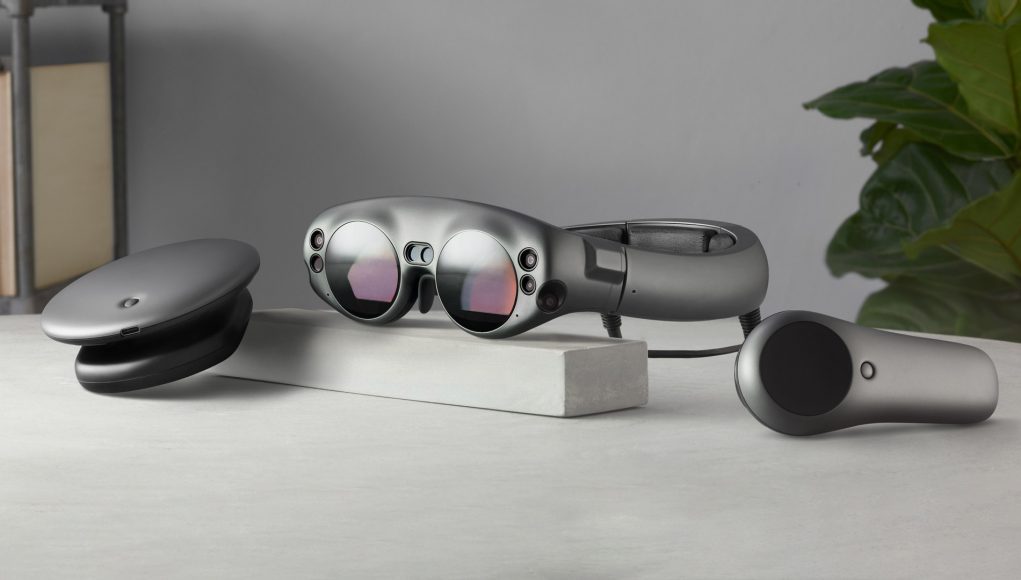In a surprise move, Magic Leap finally released images and info regarding their upcoming Magic Leap One AR headset today. Hard specs are still thin on the ground at the moment, but it appears that press embargoes on information are finally being lifted as the company looks forward to an official release of its Creator Edition headset in 2018. Magic Leap gave Rolling Stone the rock star treatment in their exclusive tour of the headquarters, which includes a hands-on with the headset.
With a few stipulations about what Rolling Stone reporter Brian Crecente could talk about, he was able to share a few details about the physical form of the AR headset from his trip to the company’s headquarters in Fort Lauderdale, Florida. There, he was given a one hour-long demo using Magic Leap tech.
The Hardware
According to Crecente, the headset is “lightweight, modern-looking, if not exactly stylish,” adding that it’s “certainly much sleeker than anything virtual reality has to offer.”
The headband is said to hold the goggles in place using what the company calls a ‘crown temple’ design.
To put on the goggles, a person holds either side of the plastic crown in their hands and pulls apart. The crown spreads apart into a left, right and back piece. Then you slide it onto your head like a headband.
A small oval which appears to be a speaker can be seen in the image below. Rolling Stone reports the headset contains a “tiny, high-end speakers built into the temples of the device,” which provides spatial audio.
Lightwear’s field of view (FOV) is a different story. Crecente compares it to a “a VHS tape held in front of you with your arms half extended.”

Two cables come out of the back of the headband and merge into one, Rolling Stone reports. The cables measure four or five feet in length before connecting to the system’s mobile computer, aka ‘Lightpack’. The Lightpack is composed of two rounded ‘pods’ “connected smoothly on one end to form a gap between them.”
Crecente says the 6DoF motion controller is a “rounded bit of plastic that sits comfortably in your hand and features an array of buttons,” including a touchpad and haptic feedback.
The Lightwear and Lightpack are almost toy-like in their design, not because they feel cheap – they don’t – but because they’re so light and there seems to be so little to them.
The precise nature of the display tech that the headset is using is unknown, however Crecente interestingly says that objects didn’t look transparent (a major challenge with AR displays), which means either a very bright display (and/or a demo in a very dim room), or a totally unique display which can make opaque pixels. The latter seemed to be what Magic Leap was hoping to achieve in the early days of their development, but various reports suggest that tech hasn’t materialized.
You can read more about today’s Magic Leap One announcement here.
The Demo
It’s uncertain if Rolling Stone actually got a hands-on with a Creator Edition headset, or an earlier prototype, but it’s clear Magic Leap has developed a few key demos to best show off their tech.
Crecente’s hour-long demo took place first in a testing facility separate from the headquarters, which included the sort of ‘4D’ experiences that might find their ways into theme parks, and later in the main building.
This first, over-sized demo dropped me into a science fiction world, playing out an entire scene that was, in this one case, augmented with powerful, hidden fans, building-shaking speakers and an array of computer-controlled, colorful lighting. It was a powerful experience, which showed how a theme park could craft rides with no walls or waits. Most importantly, it took place among the set-dressing of the stage, the real world props that cluttered the ground and walls around me and while it didn’t look indistinguishable from reality, it was close. To see the physical world around me, and then those creations appearing not on it, as if some sort of animated sticker, but in it, was startling.

Heading back to the main building into a room styled to look like a normal living room, Crecente got into the nitty-gritty of the headset’s day-to-day functions:
The demo area also gave me a chance to try a half dozen or so different sorts of demonstrations. My first was a visit with Gimbal, a floating robot that hovered in the mid-field between my eyes and a distant wall. I walked up to it, around it, viewed from different angles and it remained silently hovering in my view. The world around it still existed, but I couldn’t see through it. It was as if it had substance, volume, not at all a flat image. I was surprised to find that the closer I got to the robot, to an extent, the more detailed it became. Getting up close to the floating object didn’t expose pixels, it highlighted details I wasn’t able to see from afar. If I got too close, though, it sort of disappeared or I was suddenly inside the thing. Artifacts, I was told, of a demo that hasn’t yet been polished. I also noticed that the sounds of the whirring robot shifted around as I moved around it, always placing the noise where it should be no matter where I stood.
Much like Microsoft’s HoloLens AR headset, Crecente was shown how to launch a number of virtual monitors. To illustrate the spatial awareness and depth-tracking power of the headset, the company also put together a demo featuring a four-sided television which played live TV on each of its faces, where all monitors would continue playing regardless of whether Crecente could physically see them or not.
There, Crecente got a taste of what it might be like to interact with avatars in AR, as the next demo featured a woman walking through a virtual door. Although there wasn’t any interaction to speak of, it showed the potential just the same.
Crecent was allowed to talk about a collaborative AR project with Icelandic band Sigur Rós which was recently revealed. Called Tonandi, the experience let him conjure a ring of ethereal trees, and experience wisps dancing in the air.
As I wave my hands at them, they create a sort of humming music, vanishing or shifting around me. Over time, different sorts of creations appear, and I touch them, wave at them, tap them, waiting to see what sort of music the interaction will add to the growing orchestral choir that surrounds me. Soon pods erupt from the ground on long stalks and grass springs from the carpet and coffee table. The pods open like flowering buds and I notice stingray-like creators made of colorful lights floating around me. My movements, don’t just change this pocket world unfolding around me, it allows me to co-create the music I hear, combining my actions with Sigur Ros’ sounds.
Crecente says his experience with Tonandi was “effortless.”
While there was apparently much more to experience at the headquarters, Rolling Stone was shown the door after that.
Check out Rolling Stone’s full article here, which has more details including interviews with Magic Leap leadership.
– – — – –
The company doesn’t appear to have a booth at CES this year, so it may be some time before we get our hands on Magic Leap One. We’ll be keeping our eyes out for more news surrounding the headset though, so check back soon for more.







